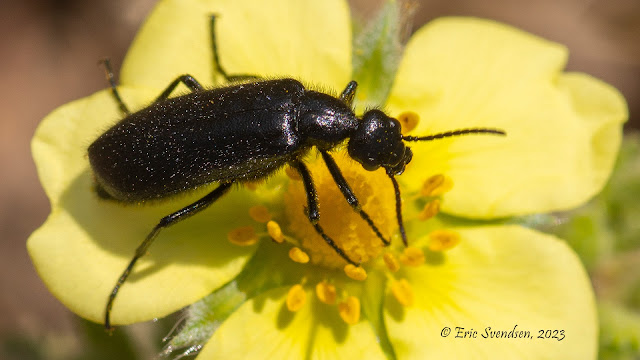Black blister beetle - an uncertain identification.
I photographed this beetle today while walking in a clearcut area populated by many wildflowers. The insect clumsily flew past me and landed on a yellow flower; I immediately was on it with my macro lens and camera setup. I usually use lens-mounted flash units to facilitate lighting. In this case, there were none, and I had only the sun's illumination to go by. It seemed to be enough.
I have spent considerable time trying to identify this species of beetle. Its body shape, size, and appendages all conform to the black blister beetle. The one thing that really throws me off though is the presence of hair, and quite a lot of it. The images I examined through book and the web did not show this to be such a hairy insect.
Regardless of my uncertain identification, I have to say that it was very interesting reading up on blister beetles. The larvae help to control grasshopper populations by consuming their eggs. The adults emerge from pupation mid-summer and feed on plant matter. They apparently have a fondness for alfalfa. This can be a problem as the beetle's blood contains a toxin that can injure or even kill other animals.
Blister beetles get their names because they will release body fluids from joints that contain the compound cantharidin. This produces blisters when it contacts skin and can cause death when injected in significant quantities. Horses have been known to die from eating feed with dead blister beetles in it. It is estimated that it takes only 4 grams of dried blister beetles to kill one. Other mammals are similarly affected.
Birds may very well eat blister beetles; the cantharidin may or may not affect them as some birds are immune to the chemical while others are resistant to its toxicity. It is interesting that some birds actually seek out the beetles as the potent chemical actually kills internal parasites and renders the bird free of them.
Cantharidin is the active ingredient in the aphrodisiac "Spanish Fly." However, the reason that the chemical seems to increase libido has more to do with swelling of the genitalia rather than causing arousal. I found an interesting statement on the substance and have included it below. The site I referenced is here.
Thanks for reading.
Eric Svendsen www.ericspix.com





Comments
Post a Comment